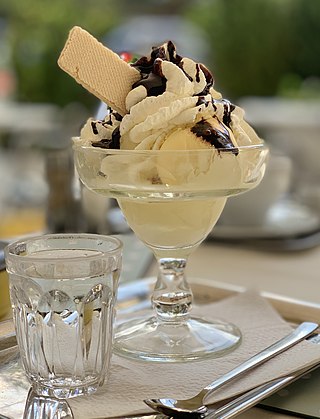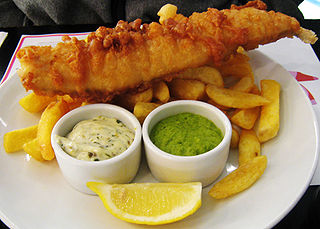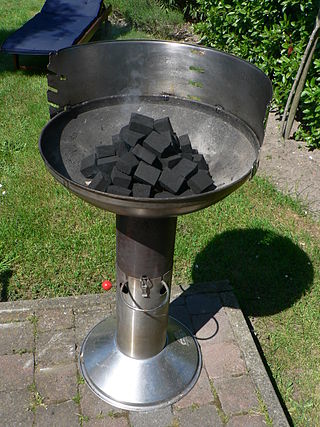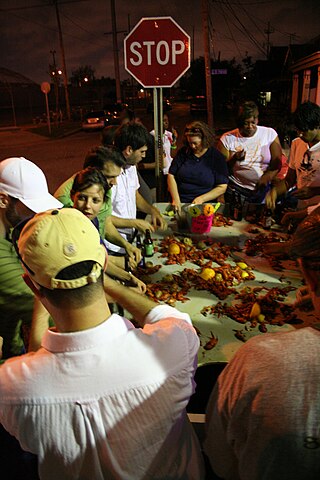
An ice cream social (also known as an ice cream party) is a planned event, where the main focus is to have ice cream served to the guests. It is often a neighborhood event or welcoming party, normally held during the summer. [1]

An ice cream social (also known as an ice cream party) is a planned event, where the main focus is to have ice cream served to the guests. It is often a neighborhood event or welcoming party, normally held during the summer. [1]
Ice cream socials are a traditional gathering, dating back to the 18th century in North America. The first one recorded in America was in 1744, when Maryland governor Thomas Bladen served ice cream for a dinner party. The first one in the White House was in 1802, with the 3rd U.S. president, Thomas Jefferson. When ice cream became more available to the public in the 1800s, organizations such as schools and churches started hosting them. Commencing in the 1860s, church events were often fashioned after the "ice cream gardens" common in society at the time. [2] [3] Today, they still take place in governmental and upper class circles and have spread to all classes and many types of organization with the increased popularity and availability of ice cream. [4]
Ice cream socials have expanded into elaborate affairs with many other ingredients and activities planned around it. Various online guides have sprouted up to assist planners. [5]
The world's largest ice cream social was held on January 30, 2019, in Italy with 962 people and was achieved by ALGIDA OOH - Unilever Italia. [6]

American cuisine consists of the cooking style and traditional dishes prepared in the United States. It has been significantly influenced by Europeans, Indigenous Americans, Africans, Latin Americans, Asians, Pacific Islanders, and many other cultures and traditions. Principal influences on American cuisine are European, Native American, soul food, regional heritages including Cajun, Louisiana Creole, Pennsylvania Dutch, Mormon foodways, Texan, Tex-Mex, New Mexican, and Tlingit, and the cuisines of immigrant groups such as Chinese American, Italian American, Jewish American, Greek American and Mexican American. The large size of America and its long history of immigration have created an especially diverse cuisine that varies by region.

Dessert is a course that concludes a meal. The course consists of sweet foods, such as cake, biscuit, ice cream and possibly a beverage such as dessert wine and liqueur. Some cultures sweeten foods that are more commonly savory to create desserts. In some parts of the world there is no tradition of a dessert course to conclude a meal.

The cuisine of the American Midwest draws its culinary roots most significantly from the cuisines of Central, Northern and Eastern Europe, and Indigenous cuisine of the Americas, and is influenced by regionally and locally grown foodstuffs and cultural diversity.

Thai cuisine is the national cuisine of Thailand.

Confectionery is the art of making confections, which are food items that are rich in sugar and carbohydrates. Exact definitions are difficult. In general, however, confectionery is divided into two broad and somewhat overlapping categories: bakers' confections and sugar confections. The occupation of confectioner encompasses the categories of cooking performed by both the French patissier and the confiseur.

Ice cream is a frozen dessert typically made from milk or cream that has been flavoured with a sweetener, either sugar or an alternative, and a spice, such as cocoa or vanilla, or with fruit, such as strawberries or peaches. Food colouring is sometimes added in addition to stabilizers. The mixture is cooled below the freezing point of water and stirred to incorporate air spaces and prevent detectable ice crystals from forming. It can also be made by whisking a flavoured cream base and liquid nitrogen together. The result is a smooth, semi-solid foam that is solid at very low temperatures. It becomes more malleable as its temperature increases.

Pavlova is a meringue-based dessert. Originating in either Australia or New Zealand in the early 20th century, it was named after the Russian ballerina Anna Pavlova. Taking the form of a cake-like circular block of baked meringue, pavlova has a crisp crust and soft, light inside. The confection is usually topped with fruit and whipped cream. The name is commonly pronounced pav-LOH-və or pahv-LOH-və, and occasionally closer to the name of the dancer, as PAHV-lə-və.

Camping is a form of outdoor recreation or outdoor education involving overnight stays with a basic temporary shelter such as a tent. Camping can also include a recreational vehicle, sheltered cabins, a permanent tent, a shelter such as a bivy or tarp, or no shelter at all. Typically, participants leave developed areas to spend time outdoors, in pursuit of activities providing them enjoyment or in a form of educational experience. Spending the night away from home distinguishes camping from day-tripping, picnicking, and other outdoor activities.

An ice cream van (British) or ice cream truck is a commercial vehicle that serves as a cold-food specialty food truck or a mobile retail outlet for pre-packaged ice cream, usually during the spring and summer. Ice cream vans are often seen parked at public events, or near parks, beaches, or other areas where people congregate. Ice cream vans often travel near where children play — outside schools, in residential areas, or in other locations. They usually stop briefly before moving on to the next street. Along the sides, a large sliding window acts as a serving hatch, and this often displays pictures of the available products and their prices. Most ice cream vans tend to sell both pre-manufactured ice pops in wrappers, and soft serve ice cream from a machine, served in a cone, and often with a chocolate flake, a sugary syrup, or toppings such as sprinkles. While franchises or chains are rare within the ice cream truck community, some do exist.

A sundae is an ice cream frozen dessert of American origin that typically consists of one or more scoops of ice cream topped with sauce or syrup and other toppings such as sprinkles, whipped cream, marshmallows, peanuts, maraschino cherries, or other fruits.

Deviled eggs, also known as stuffed eggs, curried eggs or dressed eggs, are hard-boiled eggs that have been peeled, cut in half, and filled with the yolk, mixed with other ingredients such as mayonnaise and mustard. They are generally served cold as a side dish, appetizer or a main course during gatherings or parties. The dish's origin can be seen in recipes for boiled, seasoned eggs as far back as ancient Rome, where they were traditionally served as a first course. The dish is popular in Europe, North America and Australia.

A food truck is a large motorized vehicle or trailer equipped to store, transport, cook, prepare, serve, and/or sell food.

Fried fish is any fish or shellfish that has been prepared by frying. Often, the fish is covered in batter, egg and breadcrumbs, flour, or herbs and spices before being fried and served, often with a slice of lemon.

Tea culture is defined by how tea is made and consumed, how people interact with tea, and the aesthetics surrounding tea drinking.

A fish fry is a meal containing battered or breaded fried fish. It usually also includes french fries, coleslaw, macaroni salad, lemon slices, tartar sauce, hot sauce, malt vinegar and dessert. Some Native American versions are cooked by coating fish with semolina and egg yolk.

Barbecue varies by the type of meat, sauce, rub, or other flavorings used, the point in barbecuing at which they are added, the role smoke plays, the equipment and fuel used, cooking temperature, and cooking time.

An apple dumpling is a baked or boiled pastry-wrapped apple. To prepare apple dumplings, apples are peeled, cored and sometimes quartered and placed on a portion of dough. The hole from the core may be filled with cinnamon, butter and sugar and sometimes dried fruit such as raisins, sultanas, or currants. The dough is folded over the apples and sealed. Sometimes a spiced sauce is poured over the dumplings which are then baked until tender; the sugar and butter create a sweet sauce. Apple dumplings can be served hot, cold, or room temperature for breakfast, dessert, or as a main dish.

Seafood boil in the United States is the generic term for any number of types of social events in which shellfish, whether saltwater or freshwater, is the central element. Regional variations dictate the kinds of seafood, the accompaniments and side dishes, and the preparation techniques. In some cases, a boil may be sponsored by a community organization as a fund-raiser or a mixer. In this way, seafood boils are like a fish fry, barbecue, or church potluck supper. Boils are also held by individuals for their friends and family for a weekend get-together and on the holidays of Memorial Day and Independence Day. While boils and bakes are traditionally associated with coastal regions of the United States, there are exceptions.

Agnes Bertha Marshall was an English culinary entrepreneur, inventor, and celebrity chef. An unusually prominent businesswoman for her time, Marshall was particularly known for her work on ice cream and other frozen desserts, which in Victorian England earned her the moniker "Queen of Ices". Marshall popularised ice cream in England and elsewhere at a time when it was still a novelty and is often regarded as the inventor of the modern ice cream cone. Through her work, Marshall may be largely responsible for both the look and popularity of ice cream today.

The cuisine of the antebellum United States characterizes American eating and cooking habits from about 1776 to 1861. During this period different regions of the United States adapted to their surroundings and cultural backgrounds to create specific regional cuisines, modernization of technology led to changes in food consumption, and evolution of taverns into hotels led to the beginnings of an American temperance movement. By the beginning of the Civil War, the United States cuisine and food culture could define itself separately from that of the rest of the world.